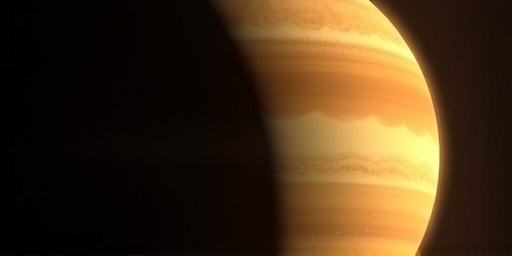In a groundbreaking revelation that could reshape our understanding of life beyond Earth, the James Webb Space Telescope (JWST) has captured infrared data suggesting the presence of organic compounds and possible water plumes erupting from Jupiter’s icy moon Europa. This discovery, announced by NASA scientists, intensifies the quest for extraterrestrial life and sets the stage for upcoming missions to probe the moon’s subsurface ocean for microbial signs.
- Infrared Spectra Reveal Carbon-Rich Organics on Europa’s Surface
- Water Plumes Erupting: Windows into Europa’s Subsurface Ocean
- NASA’s Europa Clipper Mission Gears Up for Launch
- Experts Debate Biosignatures and the Quest for Extraterrestrial Life
- Future Horizons: How Europa Could Redefine Our Cosmic Neighborhood
The findings, derived from JWST‘s sensitive Mid-Infrared Instrument (MIRI), reveal spectral signatures indicative of carbon-based molecules on Europa’s surface—key building blocks for life as we know it. Combined with evidence of water vapor plumes, these observations fuel speculation that Europa’s vast underground ocean might harbor habitable conditions, potentially teeming with primitive life forms.
NASA’s Jet Propulsion Laboratory (JPL) led the analysis, which builds on decades of intrigue surrounding Europa since the Galileo spacecraft’s flybys in the 1990s. The new data not only confirms previous hints of organics but also provides the clearest view yet of how these compounds interact with Europa’s dynamic icy crust.
Infrared Spectra Reveal Carbon-Rich Organics on Europa’s Surface
The JWST‘s infrared observations, conducted in late 2023, targeted Europa during its orbit around Jupiter, capturing light wavelengths that penetrate the moon’s reflective ice to expose underlying chemistry. Scientists identified absorption features at around 3.4 microns, characteristic of C-H bonds found in organic materials like hydrocarbons and possibly more complex biomolecules.
“These organics are not just traces; they’re distributed across regions we previously suspected to be geologically active,” said Dr. Samantha Trumbo, a planetary scientist at Cornell University and lead author on the study published in Nature Astronomy. “This suggests ongoing processes that could be delivering material from Europa’s ocean to the surface.”
The detection aligns with earlier Hubble Space Telescope images from 2016-2018, which spotted potential water plumes, but JWST’s resolution offers unprecedented detail. For instance, the data shows variations in organic concentration near Europa’s equator, where tectonic fractures might expose deeper layers. This spatial mapping is crucial for planning targeted landings or flybys.
Organics on Europa could originate from external sources like micrometeorites or Jupiter’s radiation altering surface ices, but the plumes hint at an internal source. NASA’s models estimate Europa’s ocean contains more water than all of Earth’s oceans combined, heated by tidal forces from Jupiter’s gravity. If these organics are endogenous, they bolster the case for a chemically rich environment conducive to life.
Further analysis using JWST’s Near-Infrared Spectrograph (NIRSpec) corroborated the findings, detecting possible salts and sulfates alongside the organics. These compounds, if dissolved in the ocean, could form a briny soup similar to Earth’s deep-sea vents, where life thrives without sunlight.
Water Plumes Erupting: Windows into Europa’s Subsurface Ocean
One of the most tantalizing aspects of the JWST data is the confirmation of water plumes—massive geysers spewing vapor and ice particles up to 100 miles high. Infrared imaging caught these plumes in action, with thermal signatures indicating temperatures warmer than Europa’s frigid -170°C surface average.
“The plumes are like Europa’s breath,” explained NASA project scientist Dr. Robert Pappalardo during a press briefing. “They’re sampling the ocean directly, carrying up whatever chemistry is happening below.” The observations timed plumes with Europa’s orbital position, suggesting they’re driven by tidal heating that cracks the ice shell periodically.
Historical context adds weight: Galileo’s magnetometer data in 1997 inferred a conductive ocean layer beneath the ice, while Keck Observatory’s 2018 study using adaptive optics detected hydrogen outgassing. JWST builds on this by quantifying plume composition—primarily water vapor laced with trace organics and salts.
Statistics from the mission highlight the plumes’ scale: Each eruption could release billions of kilograms of material, potentially observable from Earth-based telescopes during optimal alignments. This dynamism makes Europa a prime target for astrobiology, as plumes offer a non-invasive way to sample the ocean without drilling through kilometers of ice.
Challenges remain, however. Jupiter’s intense radiation belts degrade instruments and alter surface chemistry, which JWST’s data helps disentangle by comparing irradiated versus shadowed regions. The findings rule out purely abiotic explanations for some spectral lines, pointing toward biological possibilities, though confirmation awaits in-situ analysis.
NASA’s Europa Clipper Mission Gears Up for Launch
Fueled by JWST’s revelations, NASA’s Europa Clipper mission is accelerating preparations for a 2024 launch window. Slated to arrive at Jupiter in 2030, the spacecraft will perform dozens of flybys, using a suite of instruments to map Europa’s surface, measure magnetic fields, and analyze ejected plume material.
The $4.25 billion mission, managed by JPL, includes a high-resolution imager, mass spectrometer, and radar to peer beneath the ice. “JWST has given us a roadmap,” said Pappalardo. “We’ll target those organic-rich areas and plume sites to see if life’s signatures are present.”
Clipper’s payload draws from JWST tech, such as advanced spectrometers adapted for the harsh Jovian environment. Early mission simulations predict it could detect amino acids or lipids if they exist in plumes, providing direct evidence of extraterrestrial life.
International collaboration enhances the effort: The European Space Agency (ESA) contributes the RPWS instrument for plasma wave studies, while collaborations with Japan’s JAXA explore joint observations. Budgetary hurdles were overcome in 2021 when Congress approved full funding, underscoring bipartisan support for the search for life.
Beyond Clipper, concepts like NASA’s proposed Europa Lander aim for a 2030s touchdown to drill and analyze samples. JWST’s data will refine these plans, prioritizing sites with high organic plumes for maximum scientific return.
Experts Debate Biosignatures and the Quest for Extraterrestrial Life
The scientific community is abuzz with cautious optimism. “While these organics don’t prove life, they check many boxes for habitability,” noted Dr. Christopher Glein, a geochemist at the Southwest Research Institute. In a panel discussion hosted by the American Astronomical Society, experts emphasized distinguishing biogenic from abiotic organics— a challenge JWST addresses through isotopic ratios.
Quotes from key figures underscore the excitement: ESA’s Günther Hasinger called it “a pivotal moment for astrobiology,” while astrobiologist Dr. Lynn Rothschild from NASA Ames warned against overhyping, stating, “Europa teaches us that life might be weirder than we imagine, but we need hard evidence.”
Contextually, this fits into broader searches: JWST’s exoplanet studies and Mars rover findings provide comparative frameworks. On Mars, Perseverance detected organics in Jezero Crater, but Europa’s liquid water edges it as a stronger candidate. Statistical models from the SETI Institute estimate a 10-20% chance of microbial life in subsurface oceans across the solar system.
Public engagement is surging, with NASA’s social media campaigns garnering millions of views. Educational outreach, including virtual reality tours of Europa, aims to inspire the next generation of scientists.
Ethical considerations emerge too: If life is found, protocols from the COSPAR planetary protection guidelines will govern contamination risks, ensuring Earth’s microbes don’t hitch a ride.
Future Horizons: How Europa Could Redefine Our Cosmic Neighborhood
Looking ahead, JWST’s ongoing monitoring of Europa promises more data, with scheduled observations through 2025 to track seasonal plume variations. This could reveal seasonal chemistry changes, hinting at biological cycles.
The implications extend galaxy-wide: If Europa hosts life, it suggests subsurface oceans on exomoons like those around Kepler-1625b are viable habitats. NASA’s astrobiology roadmap now prioritizes ocean worlds, with funding boosts for missions to Enceladus and Titan.
For humanity, discovering extraterrestrial life on Europa would be transformative, challenging philosophical views on our place in the universe. As Clipper launches, the world watches, poised for answers that could confirm we’re not alone. With JWST’s eyes on the cosmos, the search intensifies, blending cutting-edge tech with timeless questions about life among the stars.









